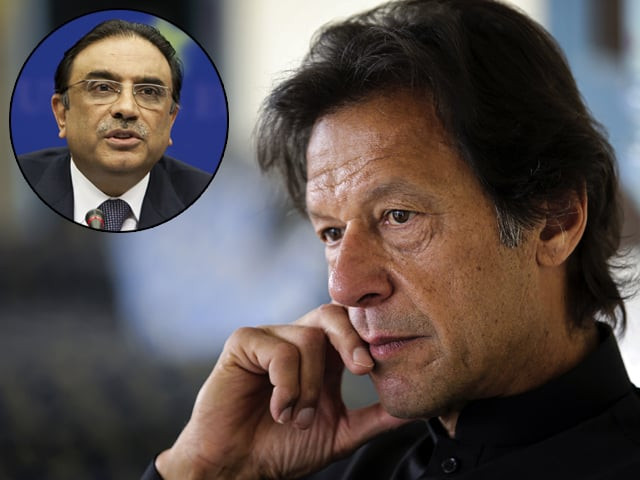The election, or as some experts satirically call it, the “selection” of the relatively unknown candidate as the Chairman of the Senate, has jolted the political landscape of Pakistan. It is now clear that those who removed Nawaz Sharif – right or wrong is a different matter altogether – are going to use all the tactics at their disposal to prevent his political comeback.
The objective in the Senate election has been achieved brilliantly by both, the Pakistan Peoples Party (PPP) and the Pakistan Tehreek-e-Insaf (PTI). They have been brought together in a surprising alliance, despite Imran Khan’s tall public promises of never shaking hands with “corrupt” politicians like Asif Ali Zardari.
All politics is realpolitik – based on pragmatism – which is why, in principle, one should not be surprised by such developments. The reality is that politics is the art of compromise, and to some extent, political parties all over the world display pragmatism by compromising on ideology.
Despite this, the alliance is not a small development, as it has “united” two extreme foes, giving us a peek into the political landscape of the future as well.
Frankly, this “alliance” may very well become a permanent template for the future, because the reality is that despite Nawaz’s disqualification, he remains popular in Punjab. I understand this is hard to grasp for the corruption-obsessed, urban, white-collar class, but clearly there is an obvious contradiction between what they think, and what the rest of the country thinks.
Since Nawaz’s disqualification, the Pakistan Muslim League-Nawaz (PML-N) has won all the by-elections, including Lodhran, which was supposedly a safe seat for the PTI. One could argue some of these victories were in rural areas, where politics is extremely local, and therefore, such wins do not reflect the national sentiment. Some assert that these victories do not prove Nawaz’s popularity has increased after the verdict. True, these victories do not show his increased appeal, but at the same time, they do reflect that despite its leader’s disqualification, the PML-N is still strongly entrenched at the local level in rural areas as well.
Moreover, in the urban areas, there are signs that Nawaz’s narrative of “mujhe kyun nikala” (why was I ousted?) is actually gaining traction. His rallies are getting bigger, and the party’s base seems to be more charged than usual.
Given the aforementioned scenario, it will be difficult to completely demolish the PML-N in the upcoming elections, even if Nawaz is put behind bars, and so-called “electable” candidates are persuaded to leave the party. Unless and until massive rigging or engineering (such as breaking up the PML-N into factions) is done, the party is still likely to emerge with the most number of seats, though probably short of simple majority.
If this does happen, the only way to prevent the PML-N from making government is through an alliance between the PPP and the PTI.
Both parties will have to come together once again, and there are two ways of going about this. The first is to announce an outright alliance, and fight elections on the basis of seat adjustment. However, the problem with this method is that it is going to be very difficult for Imran to justify such an alliance. His core support base constitutes of the urban, white collar class who hate the PPP, particularly Zardari. Thus, an open electoral alliance will demotivate his followers.
Moreover, the PPP is no longer an electoral force, the way it once used to be. Outside rural Sindh, the party’s prowess has completely evaporated. In the 2013 elections, out of a total of 297 seats, the PPP could only win six in the Punjab Assembly. In the recent by-elections as well, the PPP fared extremely poorly, and was not even able to cross the threshold of 5,000 votes. Ultimately, there is nothing the PTI is going to achieve out of such an alliance.
The second way is to engineer the kind of alliance witnessed during the Senate elections. Although feasible, the problem is that in the Senate elections, both the PPP and the PTI were in an “indirect” alliance, supporting an independent candidate. The stakes were also not as high, as in the Pakistani context, the Senate is not as important as the National Assembly. However, a post-election alliance will have to be more direct, and both parties may have to divide ministries between them, while also agreeing on a mutually acceptable prime minister.
For the PTI, the only acceptable person for the job will be Imran, and they will also be reluctant to give important ministries to the PPP. In this scenario, the PPP can support the PTI government from the outside, but such a government would be extremely weak, as it would give rise to a lot of political uncertainty and possible instability.
If the parties have to come to an alliance after the elections, then Imran will have to show flexibility and offer the PPP a substantial share in power. After all, given the chaos under this administration, a hung parliament with an unstable government is not something Pakistan can afford.
Winning the 2018 elections with Zardari and PPP, or saving his party’s ideology – what will Imran Khan choose?
It will be difficult for Imran to justify an alliance, as his core support base hates the PPP, particularly Zardari.

The only way to prevent the PML-N from making government after the 2018 elections is through an alliance between the PPP and the PTI.


COMMENTS
Comments are moderated and generally will be posted if they are on-topic and not abusive.
For more information, please see our Comments FAQ